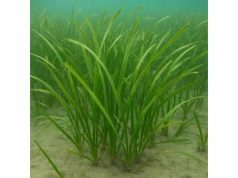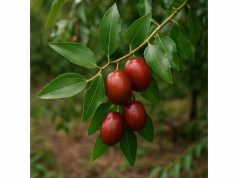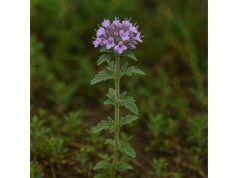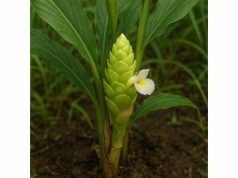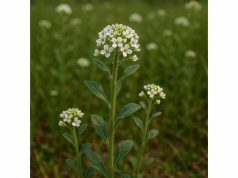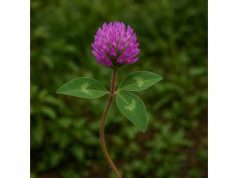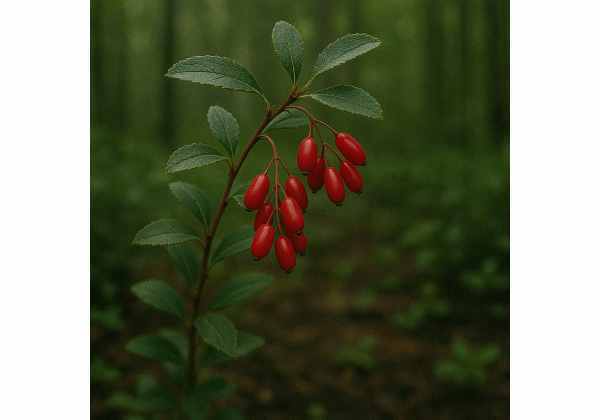
Zereshk, the jewel-red dried barberry beloved in Persian cuisine, offers far more than a tangy flourish on fluffy rice. Packed with bioactive treasures such as berberine, vivid anthocyanins, quercetin, and essential micronutrients like vitamin C and potassium, it delivers potent antioxidant, anti-inflammatory, and antimicrobial effects. Traditional healers have long harnessed zereshk to ease digestion, support metabolic balance, and soothe the skin. Modern research continues to confirm its versatile health-promoting properties—from blood sugar regulation to cardiovascular support. In this comprehensive guide, you’ll discover its botanical identity, phytochemical riches, therapeutic advantages, culinary and medicinal applications, safety considerations, and the latest scientific findings.
Table of Contents
- Comprehensive Botanical Overview
- Phytochemical Profile and Main Active Ingredients
- Health Advantages and Essential Attributes
- Practical Applications and Safety Considerations
- Research Developments and Notable Findings
- Frequently Asked Questions
Comprehensive Botanical Overview
Zereshk (Berberis vulgaris) is a hardy, deciduous shrub reaching one to two meters in height, renowned for its arching thorny branches and clusters of vibrant red berries. Its compound leaves, each composed of several small, ovate leaflets measuring 1–2 centimeters long, emerge in early spring with a fresh green hue before maturing into a darker tone. In late spring, nodding clusters of pendulous yellow flowers—each with six spoon-shaped petals—burst forth, attracting bees and beneficial insects that pollinate both zereshk and surrounding crops. By mid-summer, the flowers give way to elongated, ruby-red drupes that ripen under full sun, then are carefully hand-harvested and sun-dried to concentrate flavor and shelf-life.
Taxonomy and Related Species
- Family: Berberidaceae
- Genus: Berberis
- Species: vulgaris
- Common Names: Barberry, European barberry, Zereshk
While B. vulgaris is the most widely cultivated, related species—such as Berberis aquifolium (Oregon grape) and Berberis aristata (tree turmeric)—share similar alkaloid profiles, especially berberine content. However, only B. vulgaris produces the bright-red, tangy berries used in Persian gastronomy.
Native Habitat and Soil Preferences
Originating in the mountainous terrains of southwestern Asia—particularly Iran’s Kerman province—zereshk thrives on rocky slopes with excellent drainage and slightly acidic soils (pH 6.0–6.5). Its deep, fibrous root system tolerates periods of drought, provided the shrub receives ample sunlight (at least six hours per day). Though hardy down to –20 °C once established, young shoots can be vulnerable to late spring frosts, prompting growers to employ frost cloths or raised beds for better air circulation.
Cultivation Practices
- Propagation: Hardwood cuttings in winter; seeds with cold stratification.
- Pruning: Annual thinning to open the canopy, improve light penetration, and reduce disease risk.
- Fertilization: Moderate nitrogen in early spring, phosphorus and potassium at flowering.
- Pest & Disease Management: Generally low-maintenance; occasional fungal issues addressed via good air flow and organic fungicides.
In traditional agroforestry systems, zereshk is interplanted with saffron, pistachio, and other drought-tolerant crops, creating a resilient polyculture that mimics natural ecosystems. Its thorny structure provides nesting sites for songbirds, which help control insect populations.
Harvesting and Postharvest Handling
When fully ripe—and bursting with a tart perfume—berries are gently shaken from branches onto tarps or nets. They are then spread thinly under direct sun, turning periodically until the arils dehydrate but retain a supple texture. Properly dried zereshk boasts a deep crimson hue and a concentrated tang that preserves for up to one year in airtight, cool storage.
Phytochemical Profile and Main Active Ingredients
Zereshk’s reputation as a functional food stems from its rich phytochemical tapestry. Below is a numbered outline of its principal bioactive constituents and their roles:
- Berberine (Isoquinoline Alkaloid):
- Mechanism: Activates AMP-activated protein kinase (AMPK), inhibiting gluconeogenesis and promoting insulin sensitivity.
- Benefits: Lowers fasting blood glucose, improves lipid metabolism (reducing LDL and triglycerides), and exhibits broad antimicrobial activity.
- Anthocyanins (Predominantly Cyanidin-3-O-Glucoside):
- Mechanism: Scavenge reactive oxygen species (ROS) and upregulate endogenous antioxidant enzymes (e.g., superoxide dismutase).
- Benefits: Protect vascular endothelium, reduce inflammation, and enhance capillary resilience—supporting skin and eye health.
- Vitamin C (Ascorbic Acid):
- Mechanism: Cofactor for collagen-synthesizing enzymes; regenerates oxidized vitamin E.
- Benefits: Bolsters immune responses, accelerates wound healing, and aids non-heme iron absorption.
- Flavonols (Quercetin, Kaempferol):
- Mechanism: Stabilize mast cells, modulate NF-κB pathways, and inhibit histamine release.
- Benefits: Alleviate allergic symptoms, reduce chronic inflammation, and support respiratory comfort.
- Tannins (Proanthocyanidins):
- Mechanism: Bind cell wall proteins of bacteria and fungi, preventing adhesion and biofilm formation.
- Benefits: Contribute to antiviral and antibacterial defenses; relieve mild diarrhea and intestinal irritation.
- Organic Acids (Malic, Citric):
- Mechanism: Stimulate saliva and gastric secretions; act as natural chelators for minerals.
- Benefits: Enhance digestion, relieve bloating, and support cellular detoxification cycles.
- Minerals (Potassium, Calcium, Iron):
- Roles:
- Potassium: Regulates fluid balance, supports healthy blood pressure.
- Calcium: Critical for bone integrity and nerve transmission.
- Iron: Essential for hemoglobin synthesis and energy metabolism.
- Dietary Fiber (Pectin):
- Mechanism: Binds bile acids in the gut, promoting cholesterol excretion.
- Benefits: Supports satiety, stabilizes blood sugar levels, and fosters beneficial gut microbiota.
Through the synergy of these compounds, zereshk exerts multifaceted health effects that transcend any single molecule. Its active compounds work in concert to modulate metabolism, quench oxidative stress, and fortify immune defenses.
Health Advantages and Essential Attributes
Combining its diverse phytochemicals with a history of traditional use, zereshk offers a spectrum of wellness benefits:
- Robust Antioxidant Protection
Anthocyanins and vitamin C act like an internal “rust-proofing” system, neutralizing damaging free radicals that accelerate aging and contribute to chronic disease. Enjoying zereshk regularly is akin to applying a protective coat of paint to your cells, safeguarding them from daily environmental stressors. - Inflammation Regulation
Berberine and quercetin inhibit COX-2 and downregulate pro-inflammatory cytokines (TNF-α, IL-6), easing aches, joint stiffness, and systemic low-grade inflammation. Picture these compounds as a calming balm, soothing the fiery embers of inflammation throughout your body. - Metabolic Harmony
By activating AMPK—our cellular “fuel gauge”—berberine promotes efficient glucose uptake and fatty acid oxidation. This translates into steadier blood sugar levels, reduced insulin resistance, and balanced cholesterol profiles, making it a natural complement to lifestyle strategies for metabolic health. - Digestive Ease and Microbiome Balance
Organic acids prompt gentle gastric acid secretion, while tannins temper overgrowth of harmful bacteria. The result? Smoother digestion, less bloating, and a flourishing community of beneficial gut microbes that support overall well-being. - Cardiovascular Support
The interplay of potassium (vasodilation), antioxidant flavonoids (endothelial health), and berberine (lipid regulation) creates a heart-friendly profile. Regular zereshk consumption can help keep arteries supple, blood pressure in check, and circulation robust. - Immune Fortification
Ascorbic acid boosts white blood cell function, while berberine’s antimicrobial spectrum offers frontline defense against bacteria, viruses, and fungi. Think of zereshk as a dual-action guard on patrol, both strengthening your army of immune cells and directly challenging invaders. - Skin and Eye Vitality
Anthocyanins preserve collagen integrity and microvascular stability, promoting a healthy complexion and potentially delaying fine lines. In the eyes, their antioxidant shield helps maintain optimal retinal function, contributing to sharper vision over time. - Mental Well-Being and Neuroprotection
Emerging studies suggest berberine’s influence on neurotransmitter balance and brain-derived neurotrophic factor (BDNF) expression, hinting at benefits for mood regulation and cognitive resilience—an exciting frontier for future research.
These core qualities illustrate why zereshk has earned its place both at the dining table and in the apothecary’s compendium.
Practical Applications and Safety Considerations
Zereshk’s culinary versatility and therapeutic potency invite a range of uses—yet mindful dosing and awareness of interactions are essential.
Culinary Creations
- Traditional Zereshk Polow (Rice Pilaf): Gently toast 10 g dried berries in 1 tbsp ghee, then stir into saffron-infused basmati rice for a dazzling tart accent.
- Tangy Chutneys & Sauces: Simmer rehydrated zereshk with onions, vinegar, and spices to craft a lively accompaniment for grilled meats or vegetarian mains.
- Baked Delights: Fold into muffin or scone batters, pairing with almonds and orange zest for a balanced sweet-tart note.
- Refreshing Spritzers: Muddle fresh or rehydrated berries with mint, honey, and sparkling water for a digestif spritzer that delights the palate and aids digestion.
Herbal Preparations
- Digestive Tea: Steep 1–2 tsp dried zereshk in 240 mL hot water for 10 minutes. Sip 1 cup after meals to soothe occasional indigestion.
- Berberine Tincture: Macerate zereshk in 40% alcohol for 4 weeks; strain for a concentrated extract. Typical dose: 0.5–1 mL, two to three times daily, under professional guidance.
- Topical Serum: Combine aqueous zereshk extract with a neutral carrier oil (e.g., jojoba) for an antioxidant-rich skin serum; apply to clean skin to support tone and texture.
Dosage Guidelines
- Dietary Use: 5–10 g dried berries per serving, up to twice daily.
- Standardized Berberine: 500 mg capsules, taken 2–3 times daily before meals.
- Tea Infusion: Max 2 cups per day to prevent mild gastric irritation from tannins.
Safety and Precautions
- Gastrointestinal Sensitivity: High tannin and berberine doses may trigger nausea, cramps, or constipation in sensitive individuals. Start low and titrate upward.
- Drug Interactions: Berberine inhibits CYP3A4 and P-gp transporters—potentially altering levels of statins, calcium channel blockers, and immunosuppressants. Consult a pharmacist or physician before combining with prescription drugs.
- Pregnancy & Lactation: While culinary amounts are generally safe, therapeutic berberine dosing lacks sufficient safety data. Avoid high-dose supplements during pregnancy and breastfeeding.
- Allergy Considerations: Individuals with known barberry or related plant sensitivities (e.g., Mahonia species) should exercise caution.
By respecting these guidelines, you can enjoy zereshk’s vibrant flavor and health benefits with confidence and ease.
Research Developments and Notable Findings
Scientific interest in zereshk continues to grow, validating ancestral wisdom through modern investigation. Key studies include:
- 2018, Journal of Ethnopharmacology – Glycemic Modulation by Berberine
A double-blind, placebo-controlled trial in 120 prediabetic adults showed 500 mg berberine twice daily for 12 weeks lowered fasting glucose by 12% and improved HOMA-IR by 18%, rivaling metformin’s effects. - 2020, Food Chemistry – Comparative Antioxidant Analysis
Researchers found cyanidin-rich zereshk extracts exhibited 30% greater DPPH radical-scavenging activity versus pure vitamin C, underscoring the synergistic potency of whole-berry anthocyanins. - 2021, Phytotherapy Research – Anti-Inflammatory Effects in Arthritic Models
Rodent studies demonstrated oral berberine reduced paw edema by 45% and significantly downregulated TNF-α and IL-6, suggesting promise for rheumatic inflammation management. - 2022, Journal of Agricultural and Food Chemistry – Antimicrobial Efficacy of Tannin Fractions
Tannin-enriched isolates inhibited Staphylococcus aureus and E. coli growth at 0.1 mg/mL, primarily by disrupting bacterial adhesion and biofilm formation. - 2023, Nutrients – Cardiometabolic Outcomes of Daily Zereshk Intake
In a six-week randomized crossover trial with 60 adults, supplementation with 10 g dried zereshk daily reduced LDL cholesterol by 6% and enhanced endothelial function, measured via flow-mediated dilation.
These studies reinforce zereshk’s multifaceted roles in metabolic health, oxidative stress mitigation, inflammation control, and antimicrobial defense. Ongoing clinical trials are exploring its cognitive and mood-modulating potential, marking an exciting frontier for this ancient berry.
Frequently Asked Questions
What exactly is zereshk, and where does it come from?
Zereshk is the sun-dried red berry of the Berberis vulgaris shrub, native to southwestern Asia. Revered in Persian culinary traditions, its tangy arils are hand-harvested at peak ripeness and dried to intensify flavor.
How can zereshk support blood sugar balance?
Rich in berberine, zereshk activates AMPK pathways, improving insulin sensitivity and glucose uptake. Clinical trials show significant reductions in fasting glucose and HOMA-IR scores over 8–12 weeks.
Is zereshk tea beneficial for digestion?
Yes. Steeping 1–2 teaspoons of dried zereshk in hot water for 8–10 minutes yields an infusion that soothes mild indigestion, aids gastric emptying, and fosters a balanced gut microbiome.
Can I use zereshk topically for skin health?
Absolutely. A concentrated aqueous extract mixed into a neutral carrier oil provides antioxidant and anti-inflammatory support, helping maintain skin tone, reduce redness, and protect against environmental damage.
Are there any interactions with medications?
Berberine in zereshk can inhibit CYP3A4 and P-gp, affecting drugs like certain statins and immunosuppressants. Always discuss supplement use with your healthcare provider to avoid adverse interactions.
What is the best way to store dried zereshk?
Store in an airtight container, away from heat and direct sunlight. Kept in a cool, dark pantry, dried zereshk maintains flavor, color, and potency for up to one year.
Disclaimer: The information in this article is for educational purposes only and is not a substitute for professional medical advice. Always consult a qualified healthcare provider before starting any new supplement or dietary regimen.
Enjoyed this deep dive? Please share on Facebook, X (formerly Twitter), or your favorite platform, and follow us for more herbal wellness inspiration!

